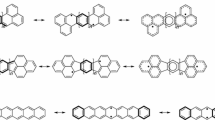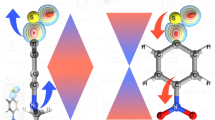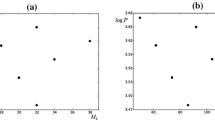Abstract
The poly-polyphenanthrene family of extended π-network strips with members ranging from polyacetylene to graphite is considered in terms of the locally correlated valence-bond or Heisenberg Hamiltonian. Resonance theory wavefunctions which provide a variational upper bound to the ground state energy are developed in a graph-theoretic formalism extendable to more general localized wavefunction cluster expansions. The graph-theoretic formalism facilitates the use of general transfer matrix techniques, which are especially powerful in application to quasi-one-dimensional systems such as are illustratively treated here. It is argued that these strips exhibit states of different long-range spin-pairing orderings. Novel properties associated with these different resulting phases are briefly indicated, including the possibilities of solitonic excitations and the reactivity at the ends of the strips. The qualitative arguments are supported by numerical calculations for strips up to width 8.
Similar content being viewed by others
References
Pauling L (1940) The nature of the chemical bond. Cornell University Press, Ithaca, New York
Van Vleck JH (1932) The theory of electric and magnetic susceptibilities. University Press, Oxford
Numerically exact computations for the ground state of the VB model have been performed for systems having up to 24 sites: Alexander SA, Schmalz TG, J Am Chem Soc (submitted)
Numerically exact computations for the ground state of the VB model have been performed for systems having up to 24 sites: see also, Ramasesha S, Soos ZG (1984) Int J Quantum Chem 25:1003
The special case of the ground state of a cyclic chain without bond-alternation turns out to be exactly soluble by a complex many-body technique which has not been extended to other structures: Hulthen L (1938) Ark Mat Astron Fys A26:1
See, for example, Mattis DC (1965) The theory of magnetism. Harper and Row, New York
Murakami M, Yoshimura S (1984) J Chem Soc Chem Commun p. 1649; (1985) Mol Cryst Liq Cryst 118:95
Tanaka K, Ohzeki K, Yamabe T, Yata S (1984) Synth Met 9:41
Seitz WA, Klein DJ, Schmalz TG, Graciá-Bach MA (1985) Chem Phys Lett 115:139
Klein DJ, Schmalz TG, Hite GE, Metropoulos A, Seitz WA (1985) Chem Phys Lett 120:367
See, e.g., Thompson CJ (1972) Mathematical statistical mechanics. Macmillan Co, New York
Early references include: Montroll EW (1941) J Chem Phys 9:706
Early references include: Kramers HA, Wannier GH (1941) Phys Rev 60:252
Early references include: Lassertre EN, Howe JP (1941) J Chem Phys 9:747
Early references include: Kubo R (1943) Busserion Kenkyu 1
For other graph-theoretic applications see, e.g., Klein DJ (1980) J Stat Phys 23:561
For other graph-theoretic applications see, e.g., Derrida B (1981) J Phys A14 L5
For other graph-theoretic applications see, e.g., Derrida B, DeSeze L (1982) J Phys 43;475
There is also the question of a “proper” derivation of such models. See, e.g., Van Vleck JH (1963) Phys Rev 49:232
There is also the question of a “proper” derivation of such models. See, e.g., Simpson WT (1956) J Chem Phys 25:1124
There is also the question of a “proper” derivation of such models. See, e.g., Herring C In: Rado GT, Stuhl H (ed) Magnetism 2B, Academic Press, NY, p. 1
There is also the question of a “proper” derivation of such models. See, e.g., Buleavski LN (1966) Zh Eksp Teor Fiz 51:230
There is also the question of a “proper” derivation of such models. See, e.g., Klein DJ, Foyt DC (1973) Phys. Rev 8A:2280
There is also the question of a “proper” derivation of such models. See, e.g., White CT, Economou EN (1982) Phys Rev 18B:3959
There is also the question of a “proper” derivation of such models. See, e.g., Malrieu JP, Maynau D (1982) J Am Chem Soc 104:3021 and 3029
There is also the question of a “proper” derivation of such models. See, e.g., Poshusta RD, Klein DJ (1982) Phys Rev Lett 48:1555
See, e.g., Van Vleck JH, Sherman A (1935) Rev Mod Phys 7:167
See, e.g., Simpson WT (1962) Theories of electrons in molecules. Prentice-Hall, Englewood Cliffs, New Jersey
See, e.g., Eyring H, Walter J, Kimball GE (1944) Quantum Chemistry, Chap. 13, John Wiley and Sons, New York
See, e.g., Simpson WT (1962) Theories of electrons in molecules. Prentice-Hall, Englewood Cliffs, New Jersey
Pauling L (1933) J Chem Phys 1:280
Pauling L, Wheland GW (1933) J Chem Phys 1:362
Pauling L, Sherman J (1933) J Chem Phys 1:679
McGlynn SP, VanQuickenborne LG, Kinoshita M, Carroll DG (1972) Introduction to applied quantum chemistry, Section 6.2. Holt, Rinehart, and Winston, Inc, New York
Herndon WC (1973) J Am Chem Soc 95:2404
Herndon WC, Ellzey ML Jr (1974) J Am Chem Soc 96:6631
Such superposition graphs constructed only from Kekulé structures often arise in graph theory and are also termed Sachs graphs, as in Trinajstic N (1983) Chemical graph theory, vol II. CRC Press, Boca Raton, Florida
Klein DJ (1979) Int J Quantum Chem 138:293
Clar E (1972) The aromatic sextet. John Wiley and Sons, New York
Su WP, Schrieffer JR, Heeger AJ (1979) Phys Rev Lett 42:1698
Rice MJ (1979) Phys Lett 71A:152
Su WP, Schrieffer JR, Heeger AJ (1980) Phys Rev B22:2099
The effects described here are in fact evident in earlier enumerations restricted to global Kekulé structures on a rather wide class of polyphene structures. See, e.g. Yen TF (1971) Theor Chim Acta 20:399
The effects described here are in fact evident in earlier enumerations restricted to global Kekulé structures on a rather wide class of polyphene structures. See, e.g. Stein SE, Brown RL (1985) Carbon 23:105
See, e.g., the reviews: Heeger AJ (1981) Comments Solid State Phys 10:53
See, e.g., the reviews: Chien JCW (1981) J Pol Sci Lett 19:249
See, e.g., the reviews: Baughman RH, Bredas JL, Chance RR, Elsenbaumer RL, Shacklette LW (1982) Chem Rev 82:209
See, e.g., the reviews: Duke CB, Paton A, Salaneck WR (1982) Mol Cryst Liq Cryst 83:177
Carter FL (1984) Physica 10D:175
Klein DJ, Garcia-Bach MA (1979) Phys Rev 19B:877
Klein DJ (1982) J Phys 15A:661
Rumer G (1932) Nachr Ges Wiss Göttingen 1932:337
See, e.g., Gantmacher FR (1959) The theory of matrices, vol II, chap. 13. Chelsea, New York
Author information
Authors and Affiliations
Additional information
Research supported by The Robert A. Welch Foundation of Houston, Texas
Rights and permissions
About this article
Cite this article
Hite, G.E., Metropoulos, A., Klein, D.J. et al. Extended π-networks with multiple spin-pairing phases: resonance-theory calculations on poly-polyphenanthrenes. Theoret. Chim. Acta 69, 369–391 (1986). https://doi.org/10.1007/BF00526698
Received:
Accepted:
Issue Date:
DOI: https://doi.org/10.1007/BF00526698




